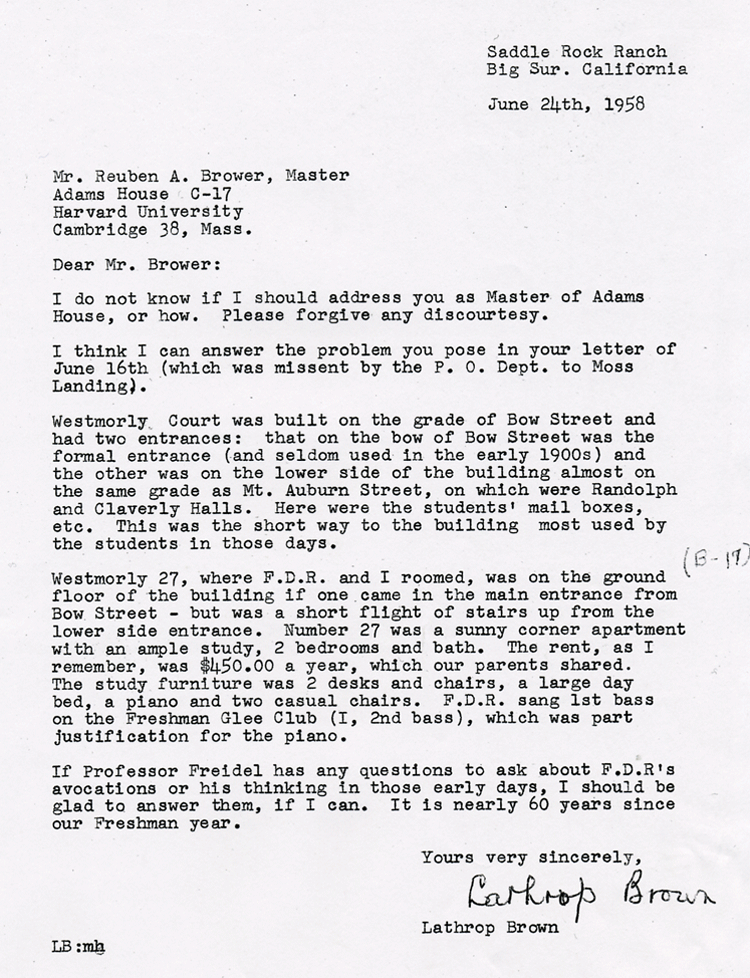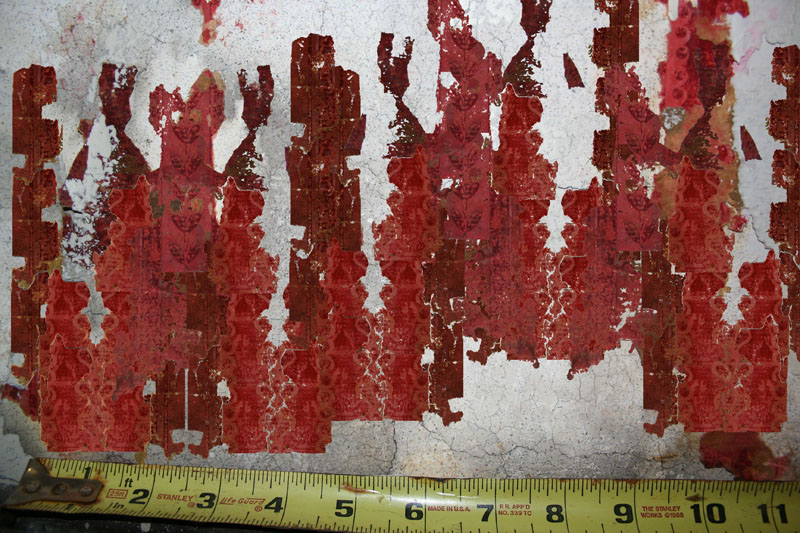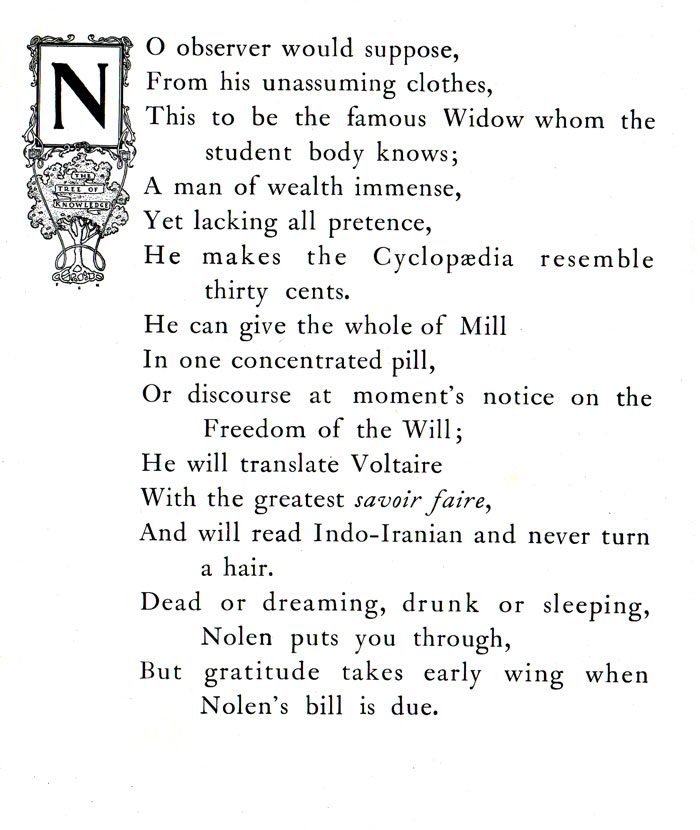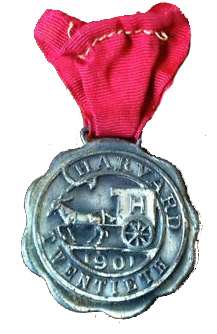A Self-Guided Tour of the FDR Suite

The Gold Coast about 1910: Claverly, Randolph, Old Russell and Westmorly Halls.
In January of 1900, FDR and his Groton chum Lathrop Brown travelled by train to Cambridge to search for rooms. At the time, Harvard provided for rooms for about 25% of its students, mostly rundown accomdations in the Old Yard that lacked running water, central heat or electricity. However, if you had money, you could lodge along what quickly became known as the Gold Coast, in the newly constructed private dormitories along Mt. Auburn Street.
As FDR wrote to Sara:
Then we went to the different agents & went all over the buildings, Randolph, Claverly, Russell and Westmorly. We saw many rooms, but the pick was at Westmorly, 1st floor corner looking on the South-West, and guess the price? $400 without extras. The floor plan is roughly like this [FDR draws suite floor plan]. We both thought it a chance and are sure of getting it as we will be given 1st choice on Mar. 1st. On the W. side of Westmorly is Russell, then Randolph, then Claverly so all four buildings are together. The sitting room is large enough for two desks & the bedrooms and bathroom are light and airy. The ceilings are very high.
The rent for the Suite in 1900 was $450; though it’s hard to compute values of money across time, real price of $450 today is $12,900.00; labor value of that amount is $57,300.00(using the unskilled wage); or $91,700.00(using production worker compensation); income value of $450 is $87,400.00. Another comparison model would be Harvard tuition. Lathrop and FDR paid $150/year. Current Harvard tuition is $43,000. By that standard of rise, the rent was $6450/month.
So what did all that money buy you? Quite a lot. The option of daily maid service for one (for an extra fee of course) porters at the door, a state-of-the-art hygienic bathroom, dual system lighting (both electric lights and gas; in 1900 the gas was far brighter and more reliable.) Across the hall, the largest swimming pool at Harvard stood ready for your private use (complete with palm trees, a river god spouting hot water and working fireplaces to dry off by); there was even a solarium on the roof. In fact, most any service you might require, including breakfast in bed until 11:00 AM, was at your beck and call. For the main meals, most students ate at Memorial Hall (now Annenburg) which was the site of the main undergraduate dining service. However, if you were wealthy like FDR, you could choose to dine elsewhere.
Until the creation of the House system in 1929, students were free to live where they pleased in Cambridge; they routinely kept the same room all four years. You were not required to move out for the summer; you simply handed your keys to the porter, left a forwarding address, and all was taken care of for you.
Westmorly hall remained a private dorm until the 1920s, when it was sold to the College as part of a land swap. In 1931 Westmorly became part of Adams House.
Restoration Background
There are no pictures of what the FDR Suite looked like when FDR lived here, though there was extensive correspondence between FDR and Sara over the decoration of the rooms (she helped and paid for the expense) as well as a 1958 letter from Lathrop Brown detailing the rooms’ general layout and content. However, thanks to a time capsule placed in the Harvard Archives known as the Chest of 1900[link to Harvard Archives], we know quite a lot about what room interiors looked like in 1900. As part of an attempt to document the University at the turn of the last century, the camera club photographed 60 odd student room interiors, both on the Gold Coast and in the Yard, including one in Westmorly B-22, the Vanderbilt Suite. This incredible resource (made all the more remarkable as it is the only year in Harvard history to receive such coverage; there are almost no photos from decades previous or after) allowed the restoration team to literally count objects in the photos to develop a list of common items to acquire. We like to joke that “this is the room E-Bay built”, but it is largely true. The Suite contains some 2000 objects all of which either date from the period, or are re-created from originals. There is no way such a collection could have ever been assembled before the advent of the Internet.
The restoration process was begun in 2008-09; the room was essentially a blank slate. It had been Professor Robert Coles’ study for many years and had fortunately received no renovations during that time. It still possesses, for instance, the original bathtub, sink and toilet. The presidential seat is a very popular photo spot.
The Suite consists of two bedrooms, bath and fire-placed study. (The fireplace works and is used often, though only when officially sanctioned!) It contains approximately 650 sq ft.
The Study
Starting at the door, and working clockwise:
The wallpaper in the study is a re-creation of what we believe to have been the original. Several tiny fragments were found behind the large radiator in the study on base plaster, and using these, designer Keri Pei and the team were able to determine the paper’s repeat. The colors are a logical guess, based on tones popular in the era.
As you enter on the right, there is a collection of mementoes on the bookshelf. There is a period football, for instance, much smaller and rounder than the one currently in use. This is the size ball in use when FDR was a student – before the advent of the forward pass make the ovoid shape easier to throw. (Harvard advocated this rule change in part because it had just built its stadium and was unwilling the widen the field – another proposal designed to decrease the density of players and prevent injuries.) There are various other football related pieces on top the bookshelf, including an original football mug, and a sports-themed water pitcher and mug. The photo of young athletes is from the Stone School, which at the time was one of the feeding prep schools to the College. The young man at the far right is Chester Robinson ’04, whose family donated this and many other pieces to the collection.
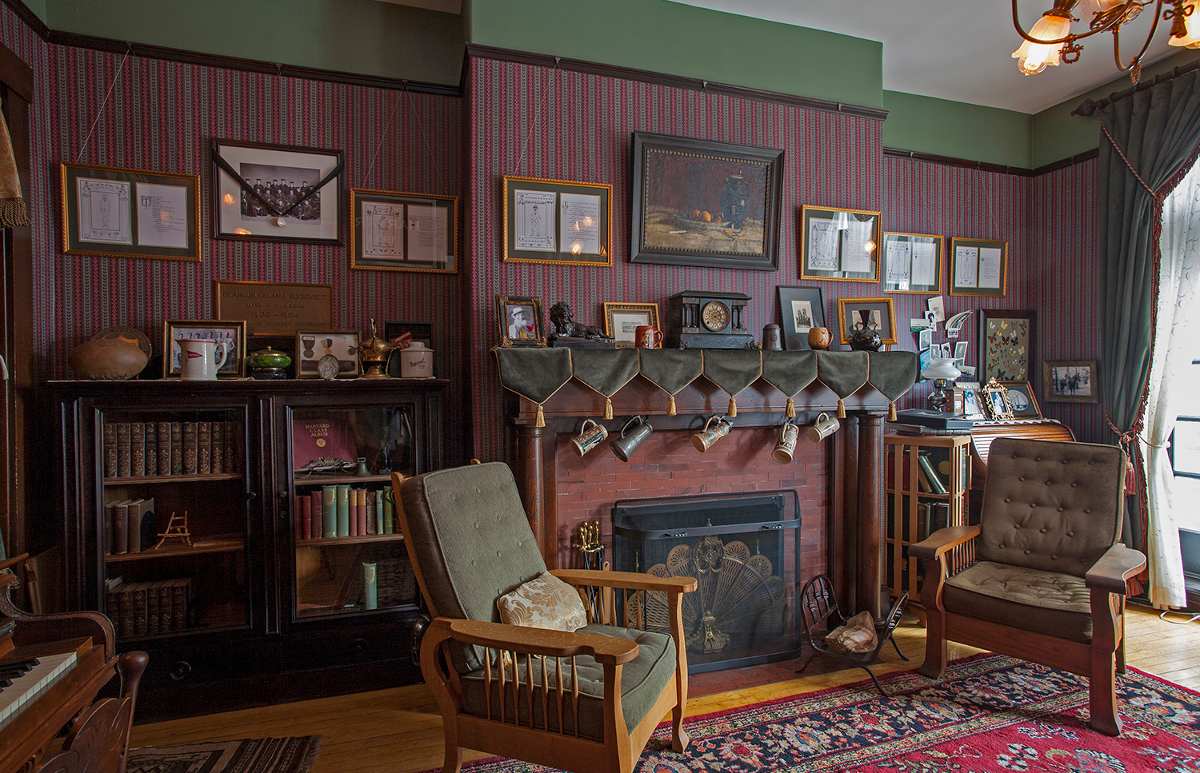
The FDR Suite Study
Over the mantelpiece hangs an impressionist still-life; it is not signed but it is very much in the style of Danish American artist Emil Carson. The large double-framed pictures on the walls are from a caricature book composed and illustrated by classmates of FDR. They feature famous Harvard personalities of the day; notable professors, the football coach, the Dean etc. One of our favorites is “The Widow” who ran a famous cram school on the corner of Plympton Street and Mt. Auburn.
(Upper-class students of Roosevelt’s time, especially if they were ‘clubmen,’ were expected not to try too hard in class. That was showing off, or worse, showing off a love of study which branded one a “dig.” A “gentleman’s C’ was the aspired to grade. FDR’s average was roughly C, Lathrop’s C minus; you can view their study cards here.
The mantelpiece also shelters our collection of John the Orangeman memorabilia. John was Harvard’s mascot. He was the only vendor allowed in the yard, and he sold oranges (and probably booze) from the back of his donkey cart for over 40 years. He was so popular with the students that they combined forces to buy him a sleigh in the winter to make sure his deliveries would get through. John was a savvy and astute businessman, and perhaps the first person at Harvard to embrace what is today known as branding. He copyrighted his image, and sold photos of himself, mugs, plaques, etc to the students and alumni, several of which now reside once again on the mantle.
The desk to the right of the fireplace is “FDR’s.” This is an arbitrary assignation, but we know from LB’s letter to Master Little in 1958 that there were two desks in the room. The single drawer roll top seems small by today’s standards, but remember it was used only for writing. This desk is almost the exact copy of one we saw in the Archive’s photo collection. The desk contains many things associated with FDR. Campaign buttons for “Cousin Ted”; a picture postcard of the house where Garfield was taken when shot and where TR became president; a loupe for examining stamps (a life-long FDR hobby); his Fly-Club pin; and many other pieces of Harvardiana. Above the desk on the wall is a collection of “cabinet cards” in a special holder we saw in many of the period photos of the day, and eventually tracked down. These cards were the Facebook of the day, and their proud display indicated the size of your acquaintance. To the right of the cabinet cards is a collection of butterflies, which were mentioned in the correspondence between FDR and Sara. This collection, which we put together, is typical of many of the objects in the Suite. Where we were unable to procure a period object, we recreated them from period models. The Morris chairs in the room and the large daybed were also custom built for us. The clustered arrangement of the furniture however is modern. The daybed (mentioned in the FDR correspondence) was most certainly smaller and may have faced the windows. Many rooms of the period have a central round table under the chandelier to capture the light for reading, with chairs haphazardly arranged around the room.
Also on FDR’s desks are pictures of Eleanor as she looked at the time of FDR’s proposal in 1903, also the girl that got away, Alice Sohier. FDR had pursued Alice ardently, but his decision to turn Democrat and his desire to have 5 children appalled her. She later told a friend “I had no desire to become a breeding cow.”
The draperies on the large French windows are modeled after a design in the 1897 Paines furniture catalogue. We now from the correspondence that Sara ordered draperies from there in September 1900. She also supplied various pieces of the furniture (though FDR notes proudly that he found the perfect small table for between the windows.”) The extent to which Sara decorated the Suite is unknown, but given her hands-on approach throughout her life (she would later build FDR and Eleanor a town house adjoining hers in NYC) chances are many of the finer touches in the room are hers.
Sara’s picture hangs above FDR’s desk to the left. It was most likely taken during one of the two winters Sara spent in Boston after FDR’s father died in the fall of his freshman year, and may have been shot by FDR himself, an ardent camera buff.
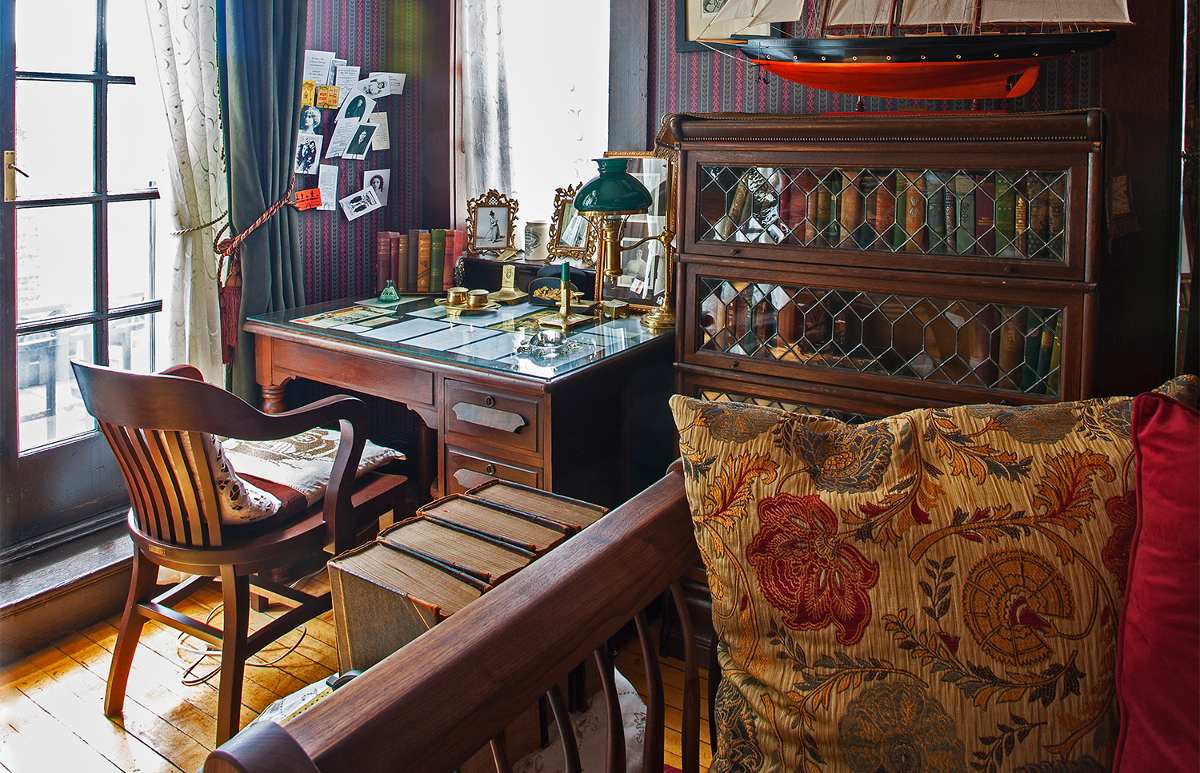
Just opposite is Lathrop Brown’s desk. This desk, too, appeared in the archival photos, and was located in a barn in New Hampshire. It’s a much simpler design than FDR’s; is made from walnut as compared to oak; and dates to a slightly earlier period 1880, vs. 1900. It, too, was inspired by a desk seen in one of the archive photos. Lathrop Brown came from a very wealthy New York family of Scottish descent. The family arrived in New York in the early 1700’s and began to acquire real estate. Lathrop’s father’s firm, Brown Harris Stevens, still exists and controls a vast real estate portfolio in NYC. Lathrop was one of four children; older brother Archie ’02, younger brother Charles, ’07, and a younger sister Lucy, who eventually became a well known artist. It is from the descendants of Lucy that we possess the Brown family photo archives Remarkably the family had preserved Lucy’s carefully labeled albums, and the Foundation carefully scanned and reproduced many of the photos you see around the Suite. On the windowsill behind Lathrop’s desk sits picture of Lucy Barnes Brown, who in addition being considered one of the loveliest young ladies in New York Society, eventually became the first woman to win the American amateur golf title.
On Lathrop’s desk also sits a double photo of a lovely young lady and a very young girl. These photos, though seemingly similar, are in fact unrelated to each other, and to Lathrop. Although we discovered many photos of Lathrop in the family archives, there appeared none that might represent a love interest, so we “created” one to adorn his desk. This is an example of creative historical narrative, and is one of the main historical threads of the Suite. While many of the objects in the Suite are of the period, and could have existed in the Suite, none actually did, to our knowledge. FDR’s possessions are all held in his presidential library in Hyde Park; Lathrop’s have been long since dispersed. Instead, we have created a plausible historical narrative to tell the tale of these two remarkable men: the date is May 17th, Saturday, 1904 and Lathrop and FDR are away, and kindly agreed to allow you the use of their Suite for the weekend. The objects contained within represent four years of Harvard accumulation, and are meant to reflect typical upper-class life at Harvard in the Edwardian period. In short, the Suite is an evocation, and is not meant to be an accurate recreation.
Beneath the glass of Lathrop’s desk sits a remarkable collection of Harvard ephemera of the period; various actual final exams, play bills, concert notices, term bills, even dance cards. These were all acquired as part of various scrapbooks collected by Harvard contemporaries. Once common, these scrapbooks appear periodically on E-bay, though now it is often more common for them to be broken up and their items sold separately. Fortunately the Foundation was able to acquire a number of these intact and select items to reproduce here.
Over the modular stained-glass bookcases sits a model of the Atlantic, built in 1903. The Atlantic would go into win the 1905 Kaiser’s Cup for the fastest transatlantic passage by a monohull, a record that would stand for 100 years. FDR was an avid collector of nautical pieces, whose collection eventually number dozens of models and thousands of other items.
On the wall is a remarkable print of Bloody Monday, a happily forgotten Harvard hazing custom.
On the small marble table next to the daybed, stands a globe from 1886, three years after FDR was born. Africa is particularly interesting, as the representation predates the division of the continent by Colonial powers.
The small table to the right of the door to FDR’s bedroom contains various smoking and personal implements, including his “dog tobacco jar”, an ingenious fob pen, a cigar shaped flask, and an Egyptian Deities cigarette box, a brand of Turkish cigarettes extremely popular in FDR’s day.
On the wall behind is view of Harvard yard in 1896; as well as a poster for the 1904 Hasting Pudding Show Boodles and Co, which FDR attended twice. (He was a member of the Pudding.) On his bedroom door, is a poster of the 1903 show HIKIYA.
Just beyond is the 1904 class picture. We’ve located Lathrop, but FDR is still to be found.
On the north wall stands the piano. FDR and Lathrop were both in the freshman Glee Club, and felt the need for a piano; it was rented for “$45 per year, which is 5 dollars off the normal price” reported FDR to Sara in 1900. This Ivers and Pond upright dates from 1898. It was located in Western MA and was completed restored for us by the Harvard Piano Service in 2009. In 2013, the piano was sent out to be converted into an electronic player; it now as a repertoire of almost a thousand songs, which are added to periodically. It also records performances, and is being used to produce a playlist of our period sheet music and Harvard University Songs.
On top of the piano, one of the famous Gibson girls gazes seductively out of an oval frame; Johnny the Bobcat and Eli the Quail are gripped in a permanent death thrall; a remarkable set of The World and Its Peoples chronicles the globe as FDR first knew it.
FDR’s Bedroom.
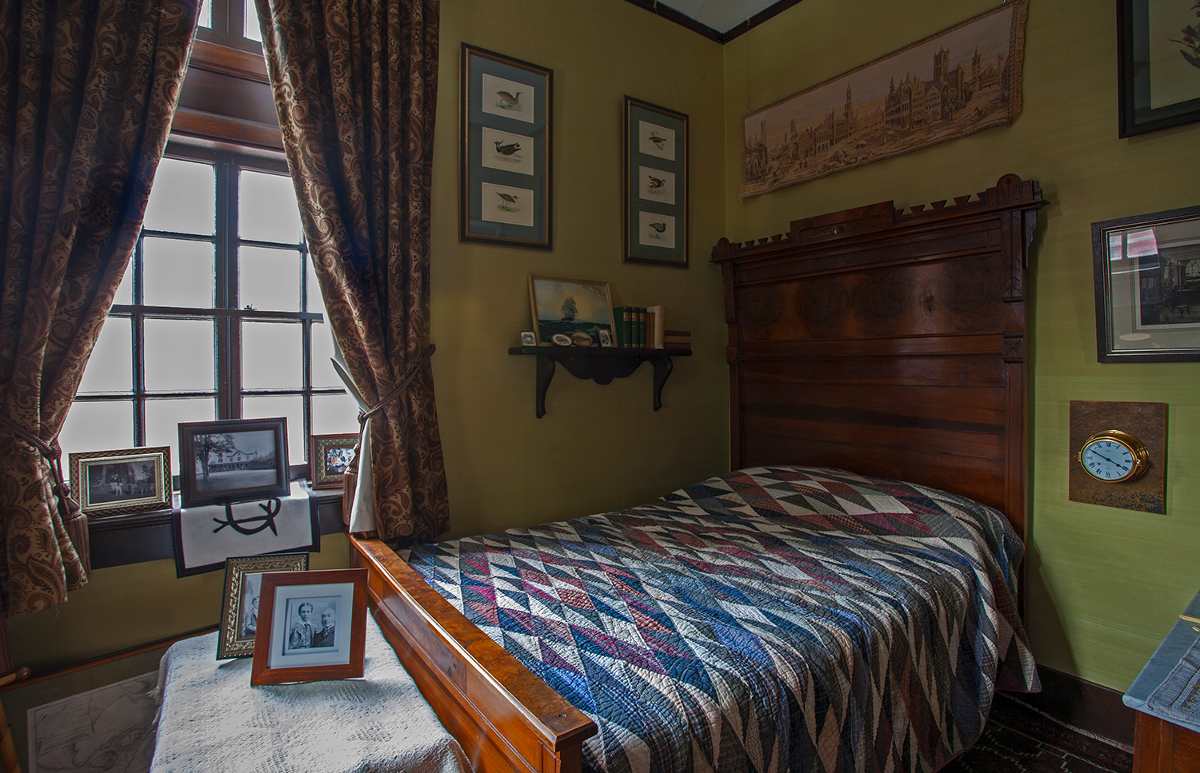
The pale green walls of this bedroom, are, like Lathrop’s, covered in silk. This type of paper, called Japan-cloth, is attested from the 1898 Vanderbilt Suite. The décor of this room reflects the passions of FDR: sailing, ornithology and travel. By the age of 17, FDR had spent almost 7 years of his life abroad, mostly because his father, in failing health, had sought various European cures. As a consequence, FDR had a working knowledge of German and French, and was intimately familiar with Europe, its politics and problems — knowledge that would come in very handy in the decades to come, first as Assistant Secretary of the Navy under Wilson, then as President. The pictures in this room are all of FDR and his family; the house at Hyde Park is also shown, before major reconstruction transformed it in 1915.
The bed set in FDR’s room is in a period style called Eastlake. The bed is almost certainly bigger than the one that would have been here — an accommodation to the fact that the Suite often houses VIP guests overnight.
On the mirrored dresser you will find various de rigueur dressing items, including a collar box, hat brush, pocket watch and various tie-pins and clips. In FDR’s day, there was a rigid dress code for most activities, and it would not have been uncommon for him to change outfits 3 or 4 times a day.
The Bath
As mentioned earlier, the fixtures, floor and woodwork in this room are entirely original, and reflected what all the bathrooms in Westmorly looked like in 1900. (It was gutted and entirely restored in 2010.) These hygienic baths were a major innovation, and represented the latest in technology. On the walls you will find various “stolen” signs; it was common practice among undergraduates to steal any sign, placard or posting that wasn’t firmly nailed down and hang the captured tributes on the walls of their rooms. If you wish to see an example of how dim the period lighting was, locate the switch outside the bath and turn off the modern recessed lighting. You can then easily see why the custom of the time was to perform as much of one’s personal toilette at dressing tables in the better-lit bedrooms.
Lathrop Brown’s Bedroom
As you enter the back bedroom, you are introduced to several of Lathrop’s passions. Sporting memorabilia, particularly football and equestrian activities, are visible on several of the walls. Lathrop managed the freshman football team, and returned the fall of his senior year to manage the Varsity. (Both he and FDR had technically completed their studies in 1903, but stayed the extra year to participate in various social activities; FDR for example, was President of the Crimson, while in addition to his football responsibilities, Lathrop was president of the Fly Club.) The pictures on the walls are all of Lathrop and his family; his mother, father, maternal grandmother, sister Lucy and brothers Charles Jr. and Archie are all represented. Through several unlikely coincidences we were able to located Lathrop’s descendants, who had miraculously preserved their photo archives. In 2010, they graciously allowed us to digitalize the entire collection of some 600 images.

On the walls above the bed, are pictures of Lathrop with the freshman football team (look for a handsome young man wearing a beanie) the first ever game in the Harvard stadium against Dartmouth (top) and a bit further down, the first ever Harvard Yale game in the stadium, November 1903. Interestingly, Lathrop, Eleanor (chaperoned by her aunt) and FDR are all in the crowd somewhere. Eleanor had come up to see FDR and visit her brother Hall at Groton, where FDR would propose the next day.
On the wall nearest the bath, is an 1899 photo of the Groton football team, next to the polo mallets. Lathrop is at the center top, the small young man again wearing the beanie, while a rather despondent FDR, sans athletic letter, looks sadly down at the lower left.
Lathrop would go on to marry one of the wealthiest women in America in 1910, Helen Hooper, the heiress to the Ames tool fortune. He served one term in Congress as a Democrat from Long Island, worked as Assistant to the Secretary of Commerce under Wilson, served briefly in WWI, and then settled down to a life of luxurious living. He died in 1959, having remained close friends with FDR until the latter’s death in 1945.

